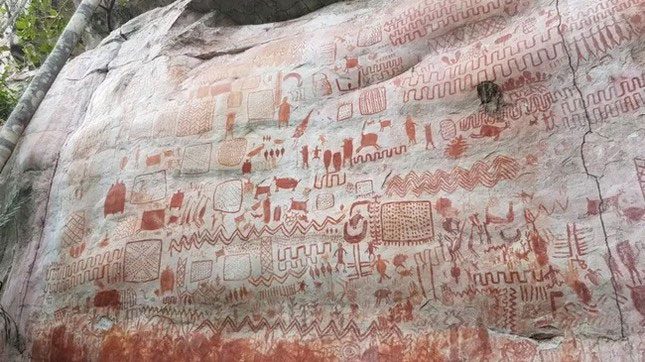Researchers have discovered that the first settlers of the Amazon River basin arrived approximately 13,000 years ago during a rapid mass migration that swept across the Americas.
Upon reaching what is now known as Serranía de la Lindosa, an archaeological site at the northern edge of the Amazon in Colombia, these early Americans lived in stone shelters, crafted stone tools, hunted, foraged, and created massive rock art, according to a new study published in the March issue of Science.

Rock art found at Serranía de la Lindosa, an archaeological site at the northern edge of the Amazon in Colombia. (Photo: University of Exeter).
Although it was previously known that this area had been inhabited by humans for at least 12,600 years, as evidenced by the rock art, researchers have gained a better understanding of how this region was utilized.
Mark Robinson, an associate professor of archaeology at the University of Exeter in the UK, stated: “The people of South America represent one of the great migrations in human history – but their arrival in the Amazon is still not well understood. For researchers working on the ground, the dense rainforest makes field identification challenging. Moreover, acidic, clay-rich soils diminish the preservation of organic remains. However, our recent excavations provide a clearer understanding of this area, revealing that it was occupied much earlier than previously understood, while also offering new insights into their lives and historical trajectory during the Holocene, the epoch following the last Ice Age that began about 11,700 years ago.”
For the new study, archaeologists collected soil samples from two rock shelters in the area. According to a statement, the research team analyzed the stratigraphy or layers of sediments and found different layers containing stone flakes, charcoal, and high levels of organic matter indicating food preparation, consumption, and disposal.
Analysis revealed periods during which the shelters were completely abandoned – in some cases for over a millennium. According to the study, researchers discovered 3,000-year-old pottery, evidence of 2,500-year-old agriculture, and traces of corn dating back 500 years. The analysis also revealed how early the sites had been utilized.
José Iriarte, a professor of archaeology at the University of Exeter, remarked: “The results confirm that human occupation at Serranía La Lindosa began in the late Pleistocene, around 12,600 years ago, and continued until the 17th century. The rock shelters found in the area provide evidence of human habitation in this region, an attractive landscape for foraging groups.”
He added that there, they had access to lush rainforests, grasslands, and rivers for hunting and gathering.
In addition to soil samples, the archaeologists also excavated animal bones, plant remains, and ochre for analysis in future studies.


















































